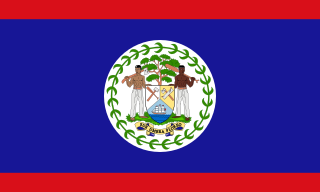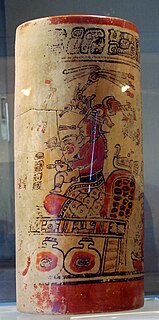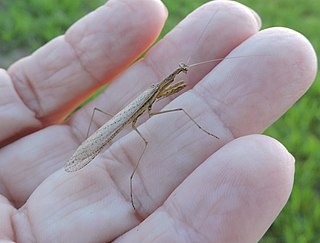
Belize is a Caribbean country located on the northeastern coast of Central America. Belize is bordered on the north by Mexico, on the east by the Caribbean Sea, and on the south and west by Guatemala. It has an area of 22,970 square kilometres (8,867 sq mi) and a population of 419,199 (2020). Its mainland is about 290 km (180 mi) long and 110 km (68 mi) wide. It has the lowest population and population density in Central America. The country's population growth rate of 1.87% per year is the second highest in the region and one of the highest in the Western Hemisphere.

Autodesk Maya, commonly shortened to just Maya, is a 3D computer graphics application that runs on Windows, macOS and Linux, originally developed by Alias Systems Corporation and currently owned and developed by Autodesk. It is used to create assets for interactive 3D applications, animated films, TV series, and visual effects.

Maya ceramics are ceramics produced in the Pre-Columbian Maya culture of Mesoamerica. The vessels used different colors, sizes, and had varied purposes. Vessels for the elite could be painted with very detailed scenes, while utilitarian vessels were undecorated or much simpler. Elite pottery, usually in the form of straight-sided beakers called "vases", used for drinking, was placed in burials, giving a number of survivals in good condition. Individual examples include the Princeton Vase and the Fenton Vase.

The Agelenidae are a large family of spiders in the suborder Araneomorphae. Well-known examples include the common "grass spiders" of the genus Agelenopsis. Nearly all Agelenidae are harmless to humans, but the bite of the hobo spider may be medically significant, and some evidence suggests it might cause necrotic lesions. However, the matter remains subject to debate. The most widely accepted common name for members of the family is funnel weaver.

Maya Khabira Rudolph is an American actress, comedian, and singer. She first gained prominence in the 1990s as a member of the alternative rock band The Rentals before joining The Groundlings improv troupe later in the decade. In 2000, Rudolph became a cast member on the NBC late-night sketch comedy series Saturday Night Live and subsequently appeared in supporting roles in films such as 50 First Dates (2004), A Prairie Home Companion (2006), and Idiocracy (2006).

Namasia District (Kanakanabu language, Bunun language: Namasia; Chinese: 那瑪夏區; Hanyu Pinyin: Nàmǎxià Qū; Tongyong Pinyin: Nàmǎsià Cyu; Wade–Giles: Na4-ma3-hsia4 Ch'ü1), formerly Sanmin Township (三民鄉; Sānmín Xiāng), is a mountain indigenous district located in the northeastern part of Kaohsiung, Taiwan. It is the second largest district in Kaohsiung after Taoyuan District.

Brosimum alicastrum, commonly known as the breadnut or ramon, is a tree species in the family Moraceae of flowering plants, whose other genera include figs and mulberries. The plant is known by a range of names in indigenous Mesoamerican and other languages, including: ojoche, ojite, ojushte, ujushte, ujuxte, capomo, mojo, ox, iximche, masica in Honduras, uje in the state of Michoacan Mexico, and mojote in Jalisco, or also chokogou in Haitian Creole.

Ancient Maya cuisine was varied and extensive. Many different types of resources were consumed, including maritime, flora, and faunal material, and food was obtained or produced through strategies such as hunting, foraging, and large-scale agricultural production. Plant domestication concentrated upon several core foods, the most important of which was maize.

The Maya civilization was a Mesoamerican civilization developed by the Maya peoples, and noted for its logosyllabic script—the most sophisticated and highly developed writing system in pre-Columbian Americas—as well as for its art, architecture, mathematics, calendar, and astronomical system. The Maya civilization developed in the area that today comprises southeastern Mexico, all of Guatemala and Belize, and the western portions of Honduras and El Salvador. It includes the northern lowlands of the Yucatán Peninsula and the highlands of the Sierra Madre, the Mexican state of Chiapas, southern Guatemala, El Salvador, and the southern lowlands of the Pacific littoral plain. “Maya" is a modern term used to refer collectively to the various peoples that inhabited this area. They did not call themselves “Maya,” and did not have a sense of common identity or political unity. Today, their descendants, known collectively as the Maya, number well over 6 million individuals, speak more than twenty-eight surviving Mayan languages, and reside in nearly the same area as their ancestors.
Oligonicella scudderi, common name Scudder's mantis or slender prairie mantid, is a species of praying mantis native to the southern United States. It is a small brown insect; the males can fly but the females are wingless.
Thesprotia subhyalina, common name grass mantis, is a species of praying mantis found in Brazil. It was originally identified as Oligonyx subhyalina.
Oligonyx is a genus of moths of the family Noctuidae erected by Shigero Sugi in 1982; the name is a junior homonym of the mantis genus OligonyxSaussure, 1869, and must be replaced, following the International Code of Zoological Nomenclature. Despite that, its only species, Oligonyx vulnerata, was first described by Arthur Gardiner Butler in 1878. It is found in south-eastern Siberia, Korea, Japan, northern and central China.

Thespidae is a family of Neotropical insects in the order Mantodea. Following a major revision of this order in 2019, the old-world subfamilies Haaniinae and Hoplocoryphinae, previously placed here, have been upgraded to family level.
Oligonyx is a genus of mantises in the family Thespidae.
Oligonyx bicornis is a species of mantid in the family Thespidae.
Oligonyx bidens is a species of mantid in the family Thespidae.
Oligonyx dohrnianus is a species of mantid in the family Thespidae.
Oligonyx insularis is a species of mantid in the family Thespidae.
Thespinae is a subfamily of mantids in the family Thespidae. There are 16 genera and at least 40 described species: found in Australasia, Central and South America.









